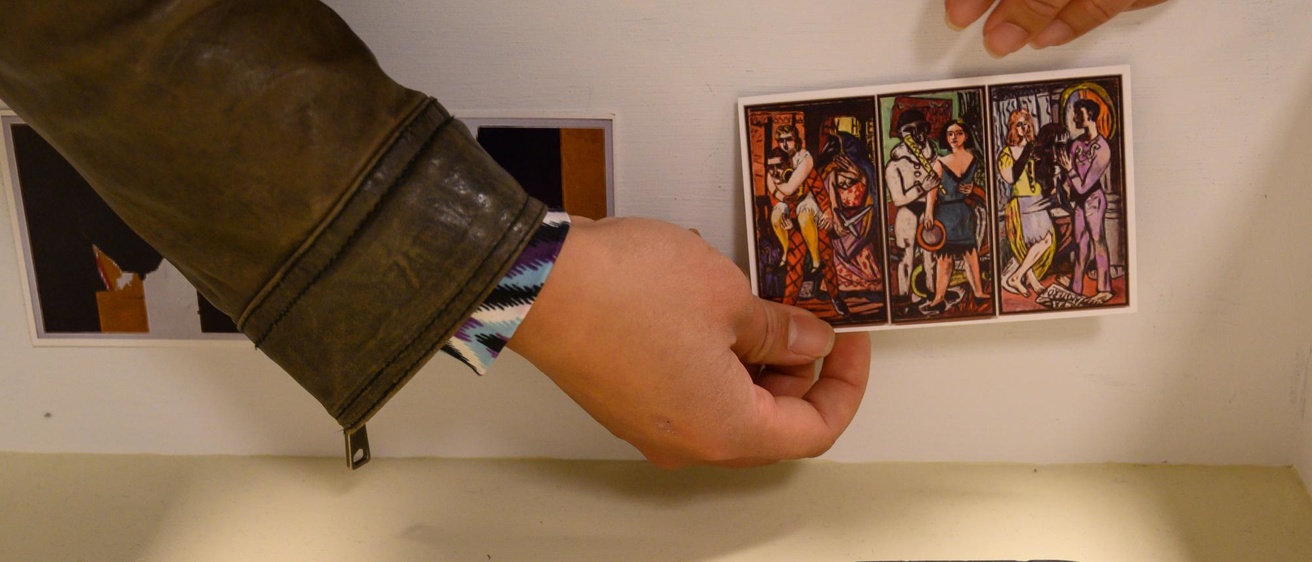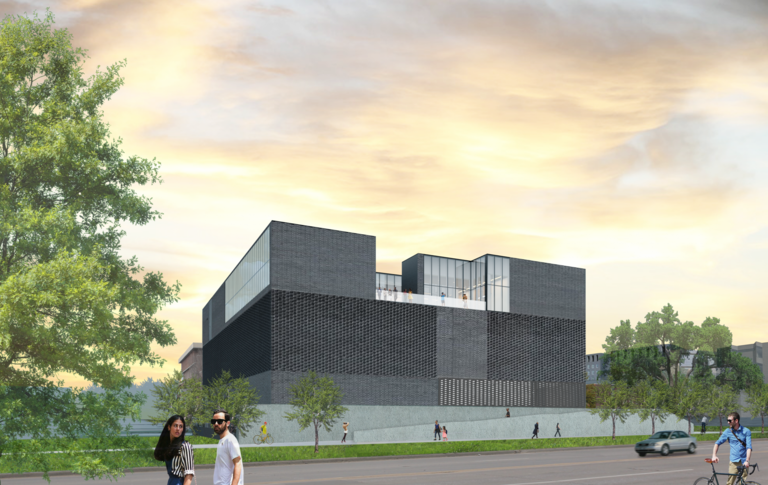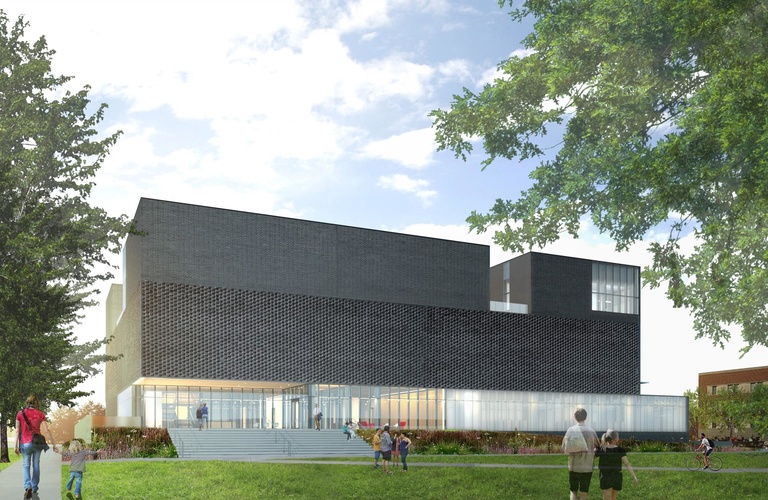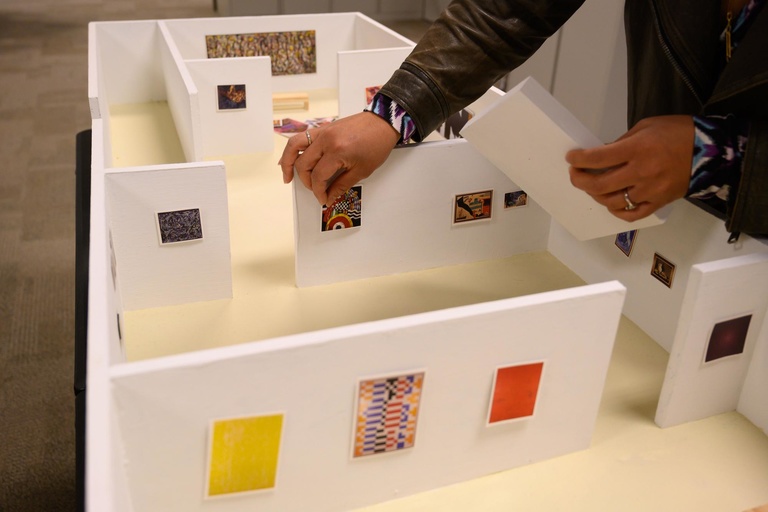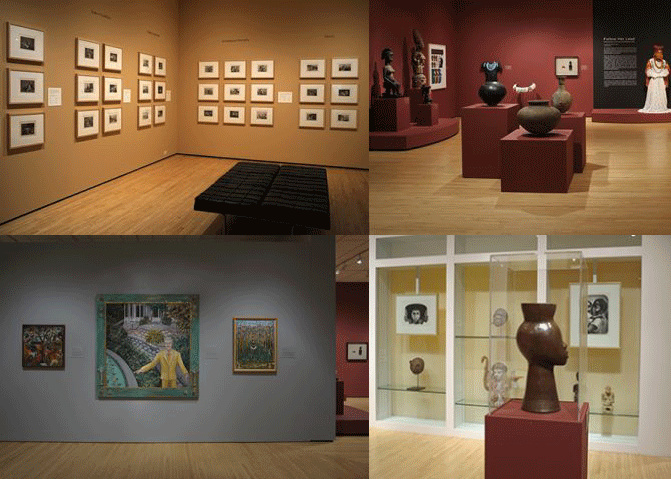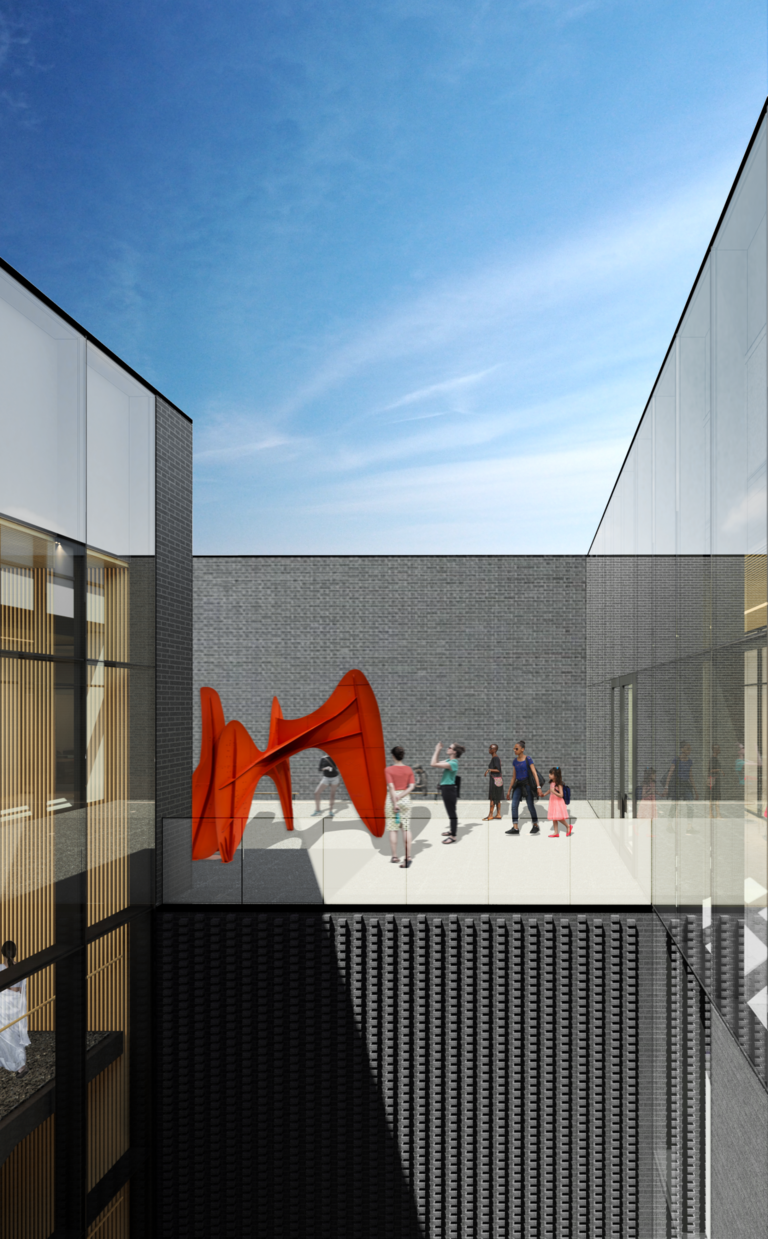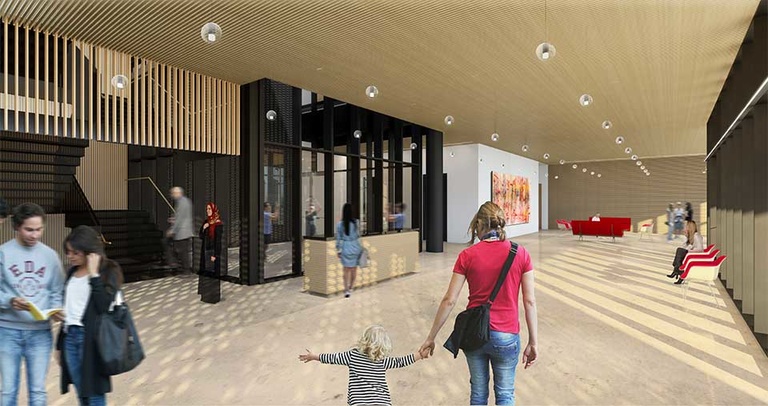As heavy machinery moves in at the future site of the new University of Iowa Stanley Museum of Art, pieces are already being hung on the walls—virtually, in miniature, and in real life.
Building highlights
- 63,000 square feet
- 16,500 square feet of gallery space
- 2,200 square feet of outdoor gallery space
- Visual classroom
- Art lounge
- Visible storage
- Three-story light well
- Underground parking
- Two outdoor terraces
More than 11 years after floodwaters forced the museum from its original building along the Iowa River, construction is underway on the new $50 million, 63,000-square-foot facility next to the UI Main Library and Gibson Square Park. Meanwhile, museum staff are preparing for an expected 2022 opening.
“We’re not just recreating what the museum was in 2008,” says Lauren Lessing, director of the UI Stanley Museum of Art. “Museums have completely shifted in the last decade from being elite institutions to being broad and populist institutions. From being places where you needed to speak in a very quiet voice to being sometimes loud and fun. We’re planning a reinstallation for this new way that museums function in the world.”
In planning the next stage in the Stanley’s future, staff are designing gallery spaces, growing the collection, ensuring art is gallery-ready, thinking about how technology can enhance the visitor experience, and fostering new partnerships and collaborations.
Designing gallery spaces
One of the first steps necessary to develop the Stanley’s inaugural installation is to determine a theme or themes.
“Along with visiting museums across the country that have recently installed collections and thinking about how to include a broader array of voices and viewpoints in the museum, we’re looking at threads that connect the whole collection,” Lessing says. “We have a collection that is very strong in several areas. We need to think broadly about how we can unite every aspect of what we are.”
Joyce Tsai, the museum’s chief curator, gives as an example one thread that has appeared while discussing the collection.
“One of the things that’s coming through in our collection is the number of artists who were and are really influential teachers,” Tsai says. “That’s particularly relevant being at a research university and an academic art museum.”
Once the themes are in place, staff can begin to figure out how the artwork will flow throughout the galleries. While 3-D modeling software SketchUp and a scale model of the galleries in which they can hang tiny art on the walls will help with this, the museum team is also testing exhibits in the Stanley Visual Classroom in the Iowa Memorial Union and through a partnership with the Figge Art Museum in Davenport, Iowa.
“We’re thinking of them as lab spaces where we can look at what stories we can tell effectively and efficiently in the spaces that we have,” Tsai says.
Growing and conserving Iowa’s art collection
When the Stanley’s new galleries open, visitors may see art that wasn’t in the museum’s collection before the flood, including pieces by currently working artists.
50 years of brilliance
The University of Iowa Stanley Museum of Art is celebrating its 50th anniversary this year.
Read more about its remarkable history.
“The university has a long history of spotting artists who are emerging and who become very, very important,” Lessing says.
Among the Stanley’s more recently acquired work is the sculpture “103” (Face Jug Series) by Simone Leigh, who has enjoyed increasing acclaim, including this spring when she unveiled a 16-foot-tall bronze sculpture titled Brick House in New York City.
“We purchased her work before it really became unattainable,” Tsai says. “What’s really remarkable about this university is that it started collecting work by cutting-edge artists early in their careers. Sam Gilliam and Yayoi Kusama have recent gained international acclaim, but some of their most important works entered our collection already in the ’70s. We have an opportunity to celebrate what we’ve achieved in the past, but also continue that vision going forward.”
Before the museum’s more than 16,000 works of art can move into their new home, some will need a bit of attention.
“Things have been on a shelf and need to be repaired or cleaned in order to look as they should to be displayed in the gallery,” Lessing says. “Even if they’re not in the gallery, we want to have them ready to go for the curriculum. The beauty of having storage on site is having the ability to rotate work through the visual classroom and the gallery.”
Conservation is an ongoing process for museums, and the Stanley has brought conservators to survey the collection in storage at the Figge Art Museum and help prioritize what needs to be done. Some work was done at the Midwest Art Conservation Center in Minneapolis, Minnesota, while other projects have been completed through the Preservation and Conservation Department in the UI Main Library.
Lessing says along with keeping artworks looking their best—as well as historically accurate—conservation also brings to light how things were made and allows the museum to tell that story to the wider public.
“How cool would it be to have an iPad hanging next to a work of art that you can flip through to see all the different layers that exist under the paint surface and have a story about how the artist put it all together?” Lessing says.
Using technology to enhance the museum experience
Lessing says she has three main goals for technology in the Stanley: to enhance people’s understanding of the collection, improve accessibility for people with disabilities such as low vision or hearing impairments, and create an opportunity for play within the museum.
However, before the museum invests a lot of time and expense into a specific technology, they want to see how people move through and use the museum—and how technology changes over the next couple of years.
“There will be tech in the space when it opens. Tablets that could show, for example, how African masks were danced and part of a larger costume and cultural practice,” Lessing says. “But we know how quickly technology moves. The technology available today might not be the best technology in 2022. We want to be flexible and responsive.”
One idea Lessing would like to investigate down the road is developing a walking-tour app, which would allow museum-goers to choose their own adventure within the museum.
“We want someone to say, ‘I’m a parent with young children,’ and be able to choose a pathway through the museum just for them,” Lessing says. “Or if they have an interest in science or spirituality, we’d have pathways for them.”
Collaborations within the museum, on campus, and beyond
The Stanley Museum of Art historically has been a place where visitors can experience artwork firsthand, and also an incubator for interdisciplinary conversation and research.
Support the Stanley
Since the floods of 2008, the UI Stanley Museum of Art has magnified its presence throughout the state and across the globe, even without a building.
The museum has hosted more art events, launched more educational programs, and reached even more art lovers than ever before.
Everyone involved wants to maintain this vital work—and their highly successful outreach programs—far beyond the move into the new building.
But it can’t be done without you.
Donate to the campaign.
Examples abound, from working with University of Iowa Hospitals & Clinics to put artwork through a CT scanner to discover secrets beneath the surface, collaborating with faculty across campus on exhibits, and partnering with experts in human-computer interaction to design technology that increases accessibility for low-sighted visitors to the museum.
“We’re at a research university. We don’t have to have all the expertise in-house,” Tsai says. “We really do benefit from partnerships.”
Along with continuing current collaborations, museum staff are working to expand and develop new partnerships. To help with this, they are hiring a curator of learning and engagement, who will focus on integrating UI faculty and students into existing programs, implementing new programs, and pursuing active collaborations across campus and in the larger community.
The museum also is introducing the Stanley Campus Council, a student advisory board that will give undergraduate and graduate students a voice in shaping how the museum engages with students through events and programs on campus.
“We want to make sure everything we do serves the purposes of research, teaching, and learning on this campus,” Lessing says.
Museum staff also are examining in-house collaboration.
“We are a small staff, but we have a real depth of expertise in multiple areas. Several members of staff are also performers, scholars, and professional artists,” Tsai says. “So, we’re developing a new exhibition planning workflow to capture their perspectives. It’s been really inspiring to see all the things each unit is capable of contributing.”
While Stanley staff will draw upon their knowledge to create the next stage in the museum’s future, they’ll also seek input from Iowans.
“This is a collection for the state, so it will be important to talk to local educators about what their students need. What do families and young professionals want? What do students want to do in the museum and what would be fun for them to know about the collection?” Lessing says. “We want to leverage the expertise of our audience and make their responses and insights part of what we present to our visitors.”
“We are not closed”
Despite all the buzz around planning for their new home, staff at the Stanley remain committed to sharing Iowa’s artistic legacy with the university community, the state of Iowa, and the world.
“I want people to be excited about the building and that it’s happening,” Lessing says. “But I also want them to know that we’re open and we’re working.”
Iowans can still see select works from the museum at the Iowa Memorial Union’s Stanley Visual Classroom and Figge Art Museum. The collection also has become a source of pride in towns as far away as Sioux City through statewide loans and outreach programs.
When it opens in 2022, the Stanley Museum of Art will be the final structure to be rebuilt on the UI campus in the aftermath of the 2008 flood. While its mission will remain largely the same, Lessing says museums worldwide are embracing new roles and rethinking what a museum is.
“We want people who just love art to come and have those moments of contemplation and renewal in front of the Jackson Pollock as they have always done,” Lessing says. “But we also want to be a place where people can go out on a Friday night and socialize and have fun and play games. We want people who didn’t know they were interested in art to find their myriad interests reflected in the collection. We want to create bridges to understanding the collection and to bring people directly into contact with extraordinary works of art.
“We’re in the weeds right now, but it’s going to be amazing when we come out the other end.”
